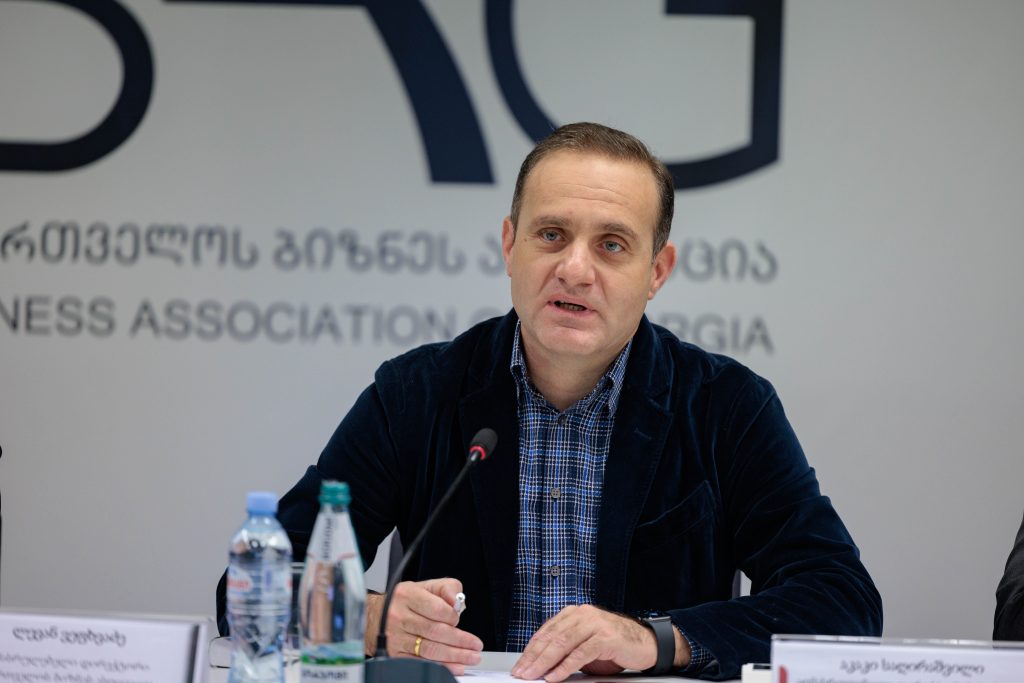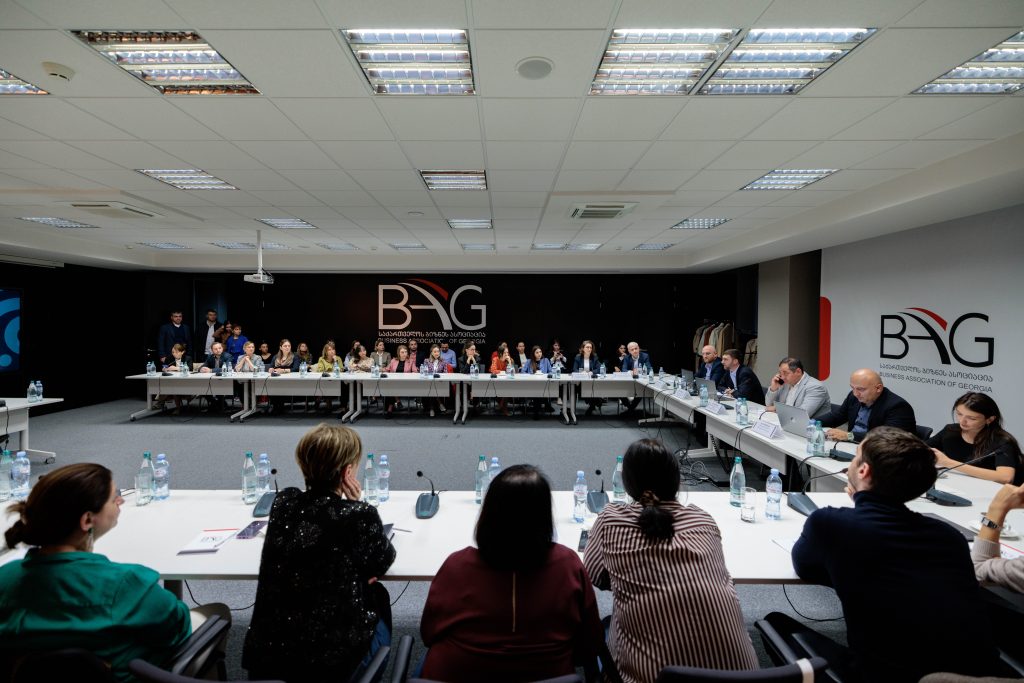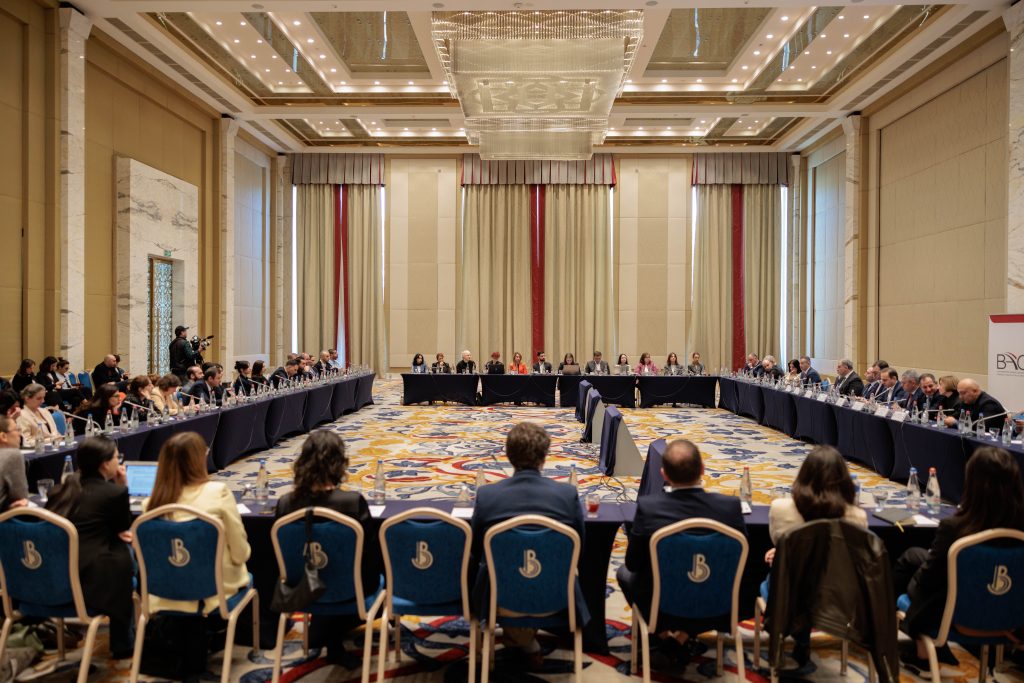Multisectoral Collaboration for Enhancing the Business Environment
What is Georgia’s potential in the realm of renewable energy, and what measures should be taken to effectively harness this potential in addressing global challenges? What role does the state play in this process, and does it possess relevant mechanisms to promote a green and circular economy? How important is the collaboration across various sectors, including the government, financial institutions, development organizations, and the civil sector, to enhance the business environment? To what extent is the business associations involved in refining the legal framework and aligning it with the European legislation, contributing to the further advancement of green energy in Georgia?

Levan Vepkhvadze, the Executive Director of the Georgian Business Association, discusses these pressing issues and more.
What is Georgia’s potential in the realm of renewable energy, and how can this potential be effectively harnessed to address global challenges and achieve established goals in mitigating the impact of climate change?
It’s hardly any news to acknowledge our substantial potential in renewable energy development. Georgia is a mountainous country, and where there are mountains and rivers, they inherently provide opportunities for harnessing hydro resources due to natural pressure differentials. Yet, our current utilization of these resources remains notably low, three or four times lagging behind countries like Austria and Norway. Thus, there remains much to do in this realm. Furthermore, we do not have a large-scale solar power plant. The existing installations are predominantly limited to 500-kilowatt capacities under every net metering scheme, and we have a big potential in this regard as well. While exploring new technologies and facilities, it’s crucial to consider the associated costs, as we shall be aware that integrating new stations into the grid can lead to increased electricity tariffs. In general, within the energy sector, the policymakers have specific issues that might conflict with one another. Here I mean three goals considered as the energy trilemma in the context of the energy sector development. Primarily, this is the economic viability – affordable electricity, i.e., energy tariffs and costs. Second, the safety factor – the consumer should be provided with electricity whenever and in the amount needed; this is related to the issue of the physical supply of electricity. Thirdly, the environmental harm shall be mitigated while generating electricity. This implies both minimization of environmental harm, including local and global impacts such as greenhouse gas emissions, during the generation of electricity.
The challenge lies in the frequent conflict among these three primary objectives. Consider, for instance, the adoption of new technologies. If the deployment of such innovations fails to achieve economies of scale, thereby reducing the cost per unit of installed capacity, the resulting electricity generation costs could surpass those of conventional or aging power plants. While hydroelectric plants can be constructed, it’s important to recognize that the electricity they produce often comes at a significantly higher cost compared to legacy facilities like those built during the Soviet Union. Conversely, older historical plants such as ‘Engurhesi’ enable us to maintain relatively low electricity prices. This explains the absence of widespread solar power adoption; current financial models for industrial-scale solar plants lack attractiveness for investment given prevailing market prices. Regarding the wind power stations, we have only one in place, due to a past governmental decision to offer a relatively high tariff over a 12-month period for a single wind plant. Consequently, we do not have any other wind power plant at this stage.
Therefore, in the end, we are moving towards the point where we need to utilize the potential, but this potential is connected, first of all, to the problem that all of this can be transformed into tangible value while the risk of tariff increases looms. The second challenge pertains to safety: renewable energy has a ‘disadvantage’: for example, it is quite difficult to predict the output of the solar and wind power plants on an hourly basis, therefore creating certain problems in terms of security of supply. Hence, within the power system, it’s imperative to have standby stations capable of immediate activation to safeguard against potential disruptions. Regrettably, we lack comparable capacities to ensure such insurance for power plants.
Certainly, we need to develop renewable energy generation capacities, but the how-to aspect requires thorough research, evaluation, and study. these prerequisites are, unfortunately, limited in our country. While there is a tendency to express the need for such initiatives at a declarative level, comprehensive studies addressing specific requirements, optimal technology percentages in the generation process, and appropriate dosages are lacking.
To what extent is the business association involved in the process of refining the legal framework and aligning it with the European legislation, to contribute to the development of green energy in Georgia?
We actively participate in the renewable energy sector, recognizing it as the path forward as an EU candidate status country. This means that our economic model should undergo a 180-degree turn towards a green and circular economy. The aim of the Association’s involvement is, on the one hand, to raise the awareness of business operators so that they are more prepared for the path we are heading towards. Nevertheless, this path ultimately involves the technological rearmament of production. To ensure our industries maintain competitiveness and avoid challenges in the export sector, a comprehensive study, assessment, and increased state support are essential. We have quite good export promotion schemes, but we do not have green or circular economy promotion mechanisms and it is important that we start working on this as soon as possible.
How can we attract investors in this realm and make them interested in the Georgian market?
There is a deficiency in competencies within the current market. I believe that, in addition to financial inflows, we should promote the introduction of technological innovations. Technological advancements will ultimately cultivate the necessary competencies. Achieving this may be nearly impossible without state intervention. Regarding the green and circular economy, as mentioned earlier, the state support schemes are not in place, while these schemes should serve as robust guarantees for the interest of foreign investors. Furthermore, having attained the status of a candidate country for the European Union accession, it is imperative that we undertake more research and gather information to enable the local businesses to maximize benefits under the relevant European schemes, identify international partners and secure appropriate financial resources to instill new dynamics in the country.
What are the advantages of being a member of the “Energy Charter” for the country? And what are the challenges in this regard?
The “Energy Charter” extends beyond the EU member states. Its core purpose is to create increased opportunities for Europe to diversify its energy supply and develop new sources for the domestic market. Europe, at a certain stage, in its pursuit of a particular developmental model, decided that such a model should also extend to its neighboring regions. The objective is to foster the free exchange of energy and advanced technologies in the field of renewable electricity. Geographic diversification is one of the approaches, enabling the instantaneous and unrestricted flow of energy between countries based on their specific needs. For instance, if the wind is blowing in Germany while it’s not in France, there is an immediate transfer of energy from Germany to France and vice versa. This swift exchange requires market mechanisms, distinct from physical supply, that create an economic multiplier and facilitate such transactions in the market.
The aim of the “Energy Charter” is to establish similar models. Although we don’t share a physical border with Europe, our membership in the “Energy Charter” positions us to play a significant role in shaping European energy security policies. Consequently, the concept of the Black Sea cable, directly linking the Georgian energy grid with Europe’s, emerged. Without our Charter membership, working on the Black Sea cable would be deemed utopian, similar to historical endeavors like connecting the Caspian region to Europe via gas and oil pipelines. Presently, European market access to renewable resources in the Caucasus region is gaining prominence, therefore, if we aim for widespread- development of renewable energy, the European market is where we can potentially export our electricity. While Georgia lacks fossil fuels like natural gas or oil for export, we do own an abundance of renewable resources. It is the ‘Energy Charter’ that provides the opportunity to access the European market within the legal framework.
Is the private sector ready to implement sustainable practices and what are the challenges they face in this respect?
Everyone desires innovation and new technology; however, the ultimate determinant is cost. While no one wishes to harm the environment, enterprises may face the risk of ceasing operations if they and their products lose competitiveness in terms of value. In other words, the expenses incurred from new capital investments and innovations result in a significant increase in production costs, leading to the expulsion of their products from the market. Addressing this challenge is paramount; our focus should be on achieving environmental protection goals by adopting more environmentally friendly technologies. On the other hand, we need to ensure that industries maintain their competitiveness in terms of cost.
In order to improve the business environment, how important is the multisectoral cooperation between the government, financial institutions, development organizations, and the civil sector?
The government, financial institutions, development organizations, and the civil sector all play crucial roles as stakeholders. Conventionally, in the construction process of a hydroelectric power station, these four entities are actively involved and interact with one another. The government, on the one hand, must grant construction permits and the right to access water. This is the minimum support provided by the state. The most significant support the state can offer is a guarantee that the generated electricity will be purchased in the market at a fixed price, either by the state itself or by the entities it encourages. As for the financial institutions – they evaluate projects critically from their perspective, determining the viability of participating in the financing of a specific project. The non-governmental sector, on the other hand, takes a critical look at the project, particularly focusing on the environmental protection aspect. As for the business sector – in this process, businesses play the role of innovator, actively seeking projects and interesting investment opportunities; subsequently, they engage with the government and financial institutions and collaborate with local communities, non-governmental organizations, and other stakeholders.
What are the future plans of the Association – what are the plans in terms of green economy, green growth, and sustainable development?
Our objective is to persuade the Government about the crucial role of state intervention and incentives in steering the economy towards sustainable practices. The state bears a significant responsibility in transitioning the economy onto “green rails,” i.e., shifting from our current economic model to a circular economy. While we all acknowledge the importance of this goal, the approach we take to achieve this goal is equally vital. This is where the Association’s place and role become pivotal – to see those challenges, which might emerge while pursuing this goal.






 Search
Search





